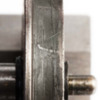There have been many posts about cleaning track, so I do not know if this will add much to the conversation, but here goes.....
Obviously, it is better to not contaminate the track and wheels to begin with!!!
I also run two rail DC, and can operate with conventional DC or the MTH DCS system. My two rail layout uses code 148 MicroScale Engineering nickel silver track, and I use Bridgewerks two handle 10 amp per side throttles. My layout has blocks.
I have noticed that the track stays much cleaner if I keep the amperage per throttle below two amps, and there are ways to do this:
1) If you run passenger trains and the cars have incandescent lights and not LED's, turn the lights out to reduce the amperage. (You can run with lights when operating at night!)
2) Try to minimize operation with smoke units turned on. Previous posts have stated that the smoke deposits an oily film on the tracks, and was the reason for the track contamination. I don't believe that. I believe that the additional amperage required to operate the smoke units increases the amperage on the track to almost four amps, and this amperage gets track dirty in a hurry. So I operate smoke only when starting a train, and minimize track deposits to only a small section of track.
3) My traditional O scale engines all have can motors and run at no more than one amp. Also, my MTH Premier engines run at no more than 1-1/2 amps without smoke. Since the power required to the track for the older O scale should be 12 volts or less, and the DCS engines run at 18 volts, the POWER (ie Volts times Amps) required for operation of the DCS engines is provided mostly by the voltage. On my two rail steam, I lube the power transfer centerplates of each tender truck with No-Ox, which is a conductive paste designed and sold to prevent brass oxidation. (You should look at EVERY interface where electricity is conducted since even one low conductance link is a weak link.)
4) If you are going to run only one engine or one lashup, there is no reason to provide power to all of the engines on the track, so use a toggle to shut off that track block.
5) I also have a three rail layout that uses DCS and a Z4000 transformer and Atlas three rail track. This track gets dirty but operation is only minimally affected. I think the reason for that is that the current (amperage) density per square inch of the TOP of the Atlas rails, the wheel to rail interface, is lower than the amperage density at the top of the rails of my MicroScale track, and this amperage spread over a wider track top surface area reduces the rail deposits. (I have no way to determine if the use of AC (vs DC) affects deposits, so cannot comment.)
6) I heard that Delrin wheels cause track and wheels to become dirty more quickly. As an Engineer, I respect Delrin but you must realize that there are several grades and varieties. So I am in the middle of a campaign to replace all Delrin wheelsets with steel wheels (two rail).
7) I use several methods to clean rail, the most used is 91% isopropyl alcohol. I also have a track car and a separate abrasive cleaner used at intervals. I have used alcohol and Qtips on wheels but the wire brush on a Dremel at low speed is quicker. I pay more attention to locomotives than to cars...and always check tender pickup wheelsets in addition to driving wheels.
With the above, I have extended the time interval when cleaning track, which I HATE, is required.









